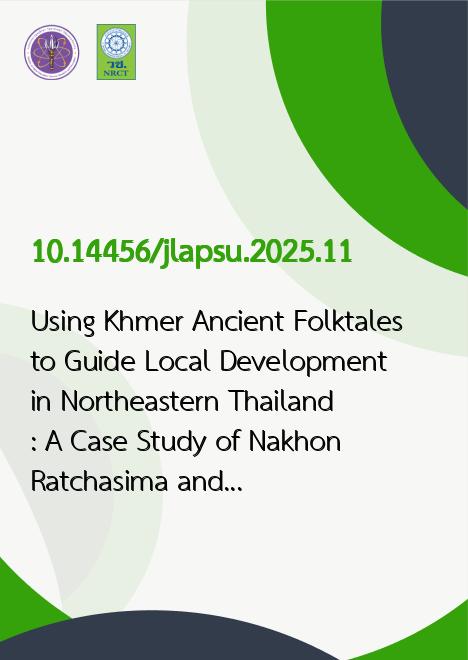
|
Using Khmer Ancient Folktales to Guide Local Development in Northeastern Thailand: A Case Study of Nakhon Ratchasima and Buriram |
|---|---|
| รหัสดีโอไอ | |
| Creator | Duangden Boonpok |
| Title | Using Khmer Ancient Folktales to Guide Local Development in Northeastern Thailand: A Case Study of Nakhon Ratchasima and Buriram |
| Contributor | Sathit Songsup, Pathima Pojanasunthorn, Kritsada Thanakun |
| Publisher | Faculty of Liberal Arts, Prince of Songkla University |
| Publication Year | 2568 |
| Journal Title | Journal of Liberal Arts, Prince of Songkla University |
| Journal Vol. | 17 |
| Journal No. | 2 |
| Page no. | 278487, pp.1-15 |
| Keyword | Folktale, Khmer Stone Temple, Community Development |
| URL Website | https://so03.tci-thaijo.org/index.php/journal-la/index |
| Website title | Journal of Liberal Arts, Prince of Songkla University |
| ISSN | 2651-1126 |
| Abstract | The purpose of this research is to study the folktales of Khmer stone temples in Nakhon Ratchasima and Buriram provinces in order to analyze them and develop guidelines for community development based on local cultural heritage. The research methodology involved field data collection, using snowball sampling and purposive selection methods to identify and connect with key individuals. Data were collected through interviews, observations, and participation in local ceremonies and festivals. The findings indicate that the story of “Pachit Orapim” is very popular and widely known in these areas. It conveys a modern love story in which the protagonist falls in love with Orapim and emphasizes the roles of talented women. Another folktale—about women and men competing to build Khmer stone temples—presents the power of women who stand up to fight for changes in culture and tradition, as well as showing women’s empowerment. The story of the god Narayana at Prasat Phanom Rung reveals the villagers’ beliefs and understanding regarding the god Narayana and the hermit Narayana. Regarding the tale of Lawo village, a female statue excavated by the villagers—named “Nang Lawo”—was later believed to represent the female Bodhisattva Prajnaparamita. This reflects the villagers’ reverence for Nang Lawo as a guardian spirit who protected their community. The findings, based on the small group discussion, revealed that the communities should also consider environmental factors and facility development for the benefit of people's daily life. Additionally, promoting cultural tourism through various activities is essential. Communities must build local brands for marketing, advertising and public relations. |